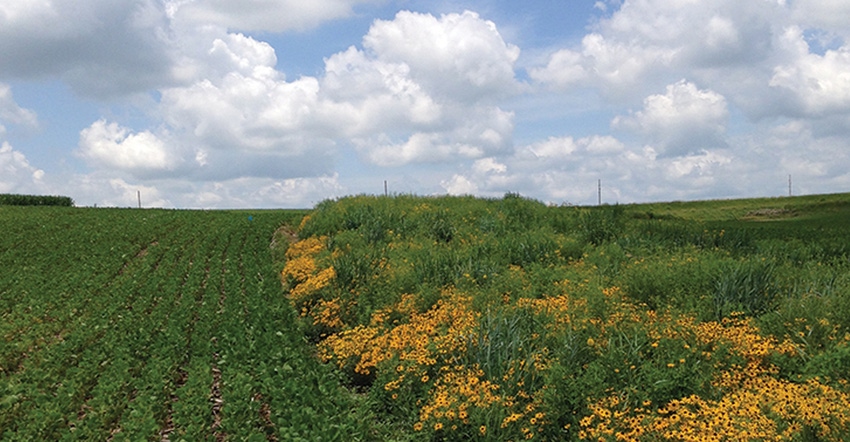June 21, 2017

A 2017 publication series by the Iowa Learning Farms can help start the conservation conversation for landowners and tenants. For some fields, a typical corn and soybean system can lead to high erosion and marginal profits. Land-use changes like prairie strips, perennial vegetation and extended rotations can be a strong choice for both the landowner and tenant.
We would like to continue with corn and soybeans, but what can be done to help reduce erosion on my hillsides?
Prairie strips are strategically placed within cropland perpendicular to the flow of water, and are sized based on the farming and machinery needs of each farm. They can be redesigned to respond to changes in machinery or sediment deposition. Strips can be placed in the field as a contour buffer strip, or on the edge of the field as a filter strip.
How much cropland is impacted when installing prairie strips?
Studies have shown that strategically converting as little as 10% of a cropped field to perennial prairie in narrow patches along contours and foot slopes can reduce sediment movement by 95%, and reduce losses of nitrogen in runoff by 84% and phosphorus by 90%.
What are the costs associated with prairie strips?
Prairie strips rank among the least expensive of in-field management practices. The average annual cost of treating a farm field with prairie strips ranges from $24 to $35 per acre. That includes establishment, management and opportunity cost per year. There are opportunities to generate income from hunting leases and cost-share programs to assist with establishment.
What about adding a third or fourth crop to the rotation?
Extending the rotation by introducing one or more crops to the corn and soybean system can reduce the application and loss of both phosphorus and nitrate. Common crops used in extended rotations include alfalfa, oats, wheat or cereal rye. A significant shift to extended rotations would increase alfalfa production and demand for livestock production, while also helping meet the growing demand for cover crops like oats, wheat and rye.
What land-use options are available to continue generating income on marginal fields?
For some fields, keeping the ground covered all year with perennial vegetation is the best option. Options for perennial vegetation include energy crops like miscanthus and switchgrass, land retirement through the Conservation Reserve Program with an annual rental payment, or conversion to grazed pasture. These practices can help significantly reduce nitrate losses by 72% to 85% and phosphorus losses by 34% to 75%.
What are some of the additional benefits of perennial vegetation?
As well as generating income, these practices can help significantly reduce nitrate losses by 72% to 85% and phosphorus losses by 34% to 75%. Furthermore, they support improved soil quality and water infiltration while reducing soil erosion. The perennial cover also helps establish wildlife and pollinator habitat, as well as migration corridors.
Final advice for someone interested in making some land-use changes?
It is recommended that the landowner and tenant work together to gather information about the practices and address management concerns before making the land-use changes. Consider starting with a small portion of the land and increase as needed, so the tenant can learn new management skills for greatest success. Your local NRCS staff and ISU Extension field specialists are available to meet with you and your tenants to help answer questions, and to provide resources and technical assistance. The ISU STRIPS team’s website is prairiestrips.org.
Read the previous three parts here:
Starting the conservation conversation on cover crops
Wetlands, bioreactors, buffers — what you need to know
Conservation through no-till, strip-till
The four-part “Talking with Your Tenant” publication series, along with other print and video resources, are available at iowalearningfarms.org/conservation. Copies are also at Iowa Learning Farms field days and workshops, or mailed upon request.
Juchems is the events coordinator for Iowa Learning Farms.
About the Author(s)
You May Also Like




